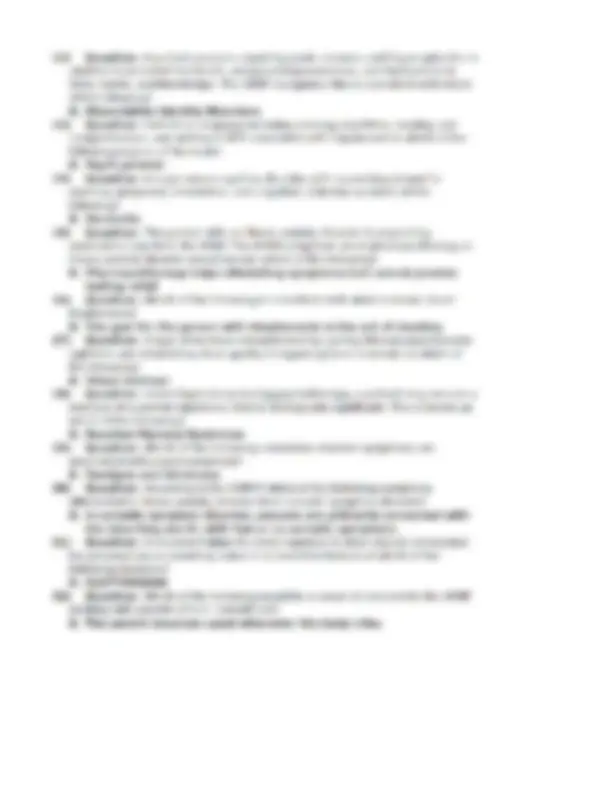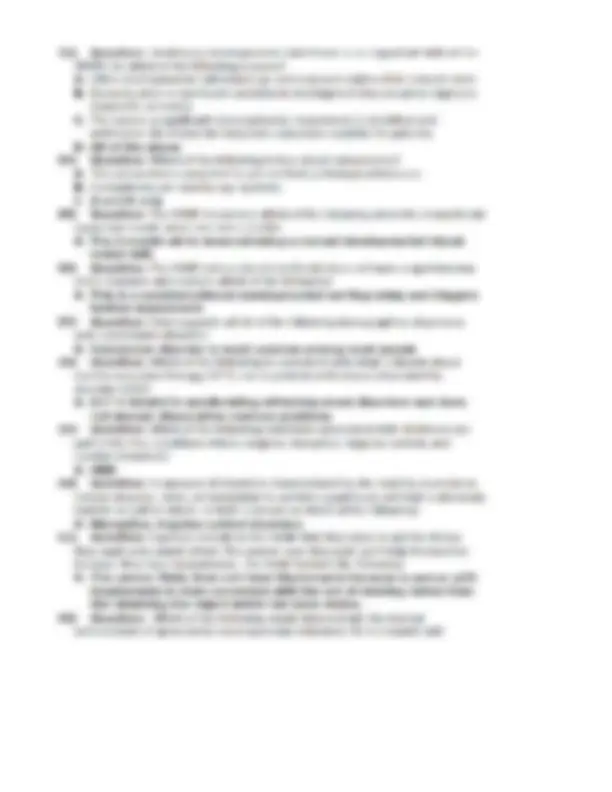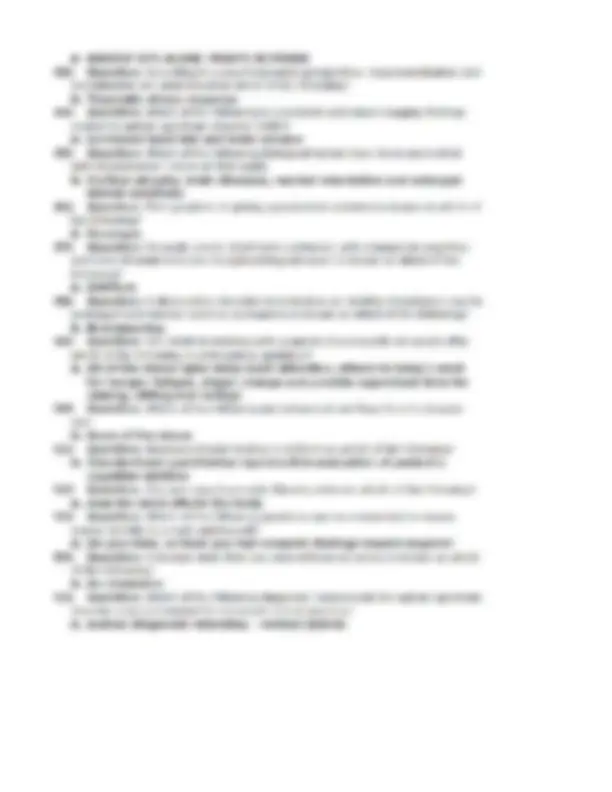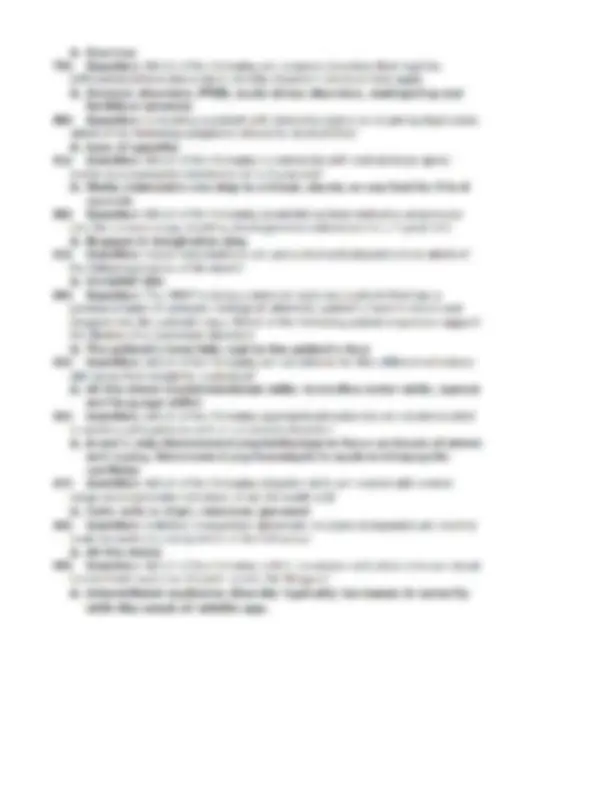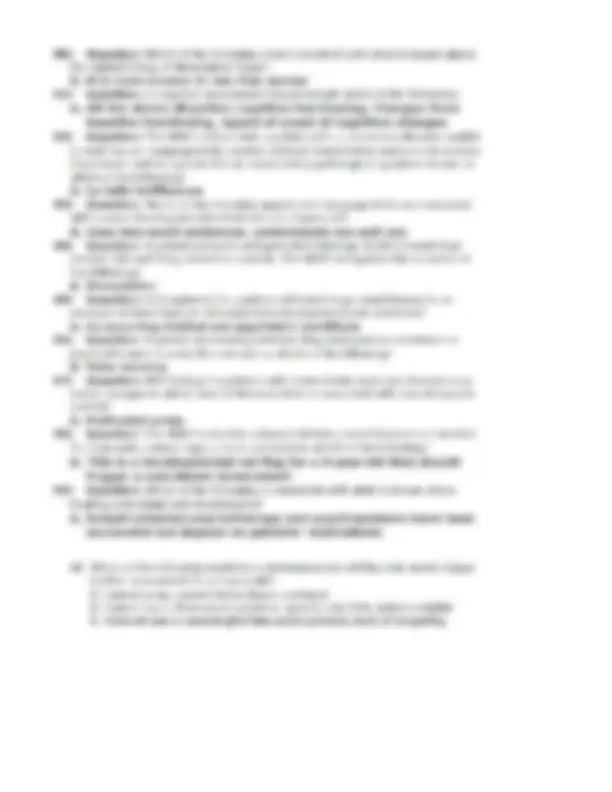Partial preview of the text
Download NRNP 6665 Final Exam (Version-1, 135 Q & A, Latest-2025) / NRNP6665 Final Exam: Walden Uni and more Exams Nursing in PDF only on Docsity!
1) Question: An illness of symptoms or deficits that affect valuntary motor or sensory functions, which suggest another medical condition but that is judged to be caused by psycholagical factors because the illness is preceded by conflicts or other stressors in known as which of the following? A. functional neurological symptom disorder Question: A condition characterized by the person giving approximate answers, with clouding of consciousness, frequently accompanied by hallucinations or other dissociative, somatoform or conversion symptoms is A. Ganser Syndrome 3) Question: Which of the following can cause delirium? Check all that apply. A. Polypharmacy B. Sleep deprivation 4) Question: Acute withdrawal from alcohol represents which type of clinical problem in psychosomatic medicine? A. Medical complications of psychiatric conditions or treatments 5) Question: The principal theoretician to bring psyche and soma together was which of the following? A. Sigmund Freud 6) Question: Which of the following would not be included in the treatment plan for a patient with illness anxiety disorder? A. Exploratory invasive procedures to obtain diagnosis 7) Question: Which of the following is consistent with current literature about the relationship between obstetrical complications and autism spectrum disorders (ASD)? A. Research proves there is a positive correlation between obstetrical complications and ASD Question: The epidemiology related to kleptomania includes which of the following? A. Kleptomania is reported to occur in fewer than 5 percent of identified shoplifters. Question: A frontotemporal dementia with onset in the fifth to sixth decade of life, more common in men, marked by personality change and cognitive decline, is known as which of the following? A. Pick’s Disease 10) Question: Which of the following demographics are consistent with autism spectrum disorder (ASD) A. Four times more common in boys than girls. 11) Question: The ARNP is working with the family of a patient with Alzheimer's Disease who keeps stating the family is plotting against her, trying to have her “snuffed out.” The family is distraught because they state they are doing their 2 9 best to make sure their family member is safe. The ARNP explains which of the following in educating the patient about the patient's A. The patient is delusional. An estimated 30 to 40 percent of patients with dementia have delusions 12) Question: Which of the following persons hypothesized that the symptoms of conversion disorder reflect unconscious conflict? A. Sigmund Freud 13) Question: Which of the following is consistent within normal range developmental milestones in adaptive skills for a 4-year-old? A. Toilets self alone; uses fork 14) Question: A temporary marked alteration in the state of consciousness or by the customary sense of personal identity without the replacement by an altemate sense of identity is known as which of the following? A. Dissociative trance disorder 15) Question: Differential diagnoses to be considered when diagnosing Ganser syndrome include which of the following? A. All the above (organic dementia, depressive pseudodementia, Korsakoff’s syndrome) 16) Question: A patient who has been raped, presents with the inability to recall important personal information and any information about the rape, does recall events prior and since. There does not appear to be any physiological reason for this. This presentation is consistent with which of the following diagnoses? A. Dissociative amnesia 17) Question: Depersonalization can result from which of the following conditions? Check all that apply. A. Seizure disorders 18) Question: A child who demonstrates repetitive significant violations of social rules and the rights of others over the course of a year would likely be diagnosed with which of the following diagnoses? A. Conduct Disorder 19) Question: A sudden unexpected purposeful travel away from home with inability to recall all of one’s past accompanied by confusion about personal identity not due to direct effects of a substance or a general medical condition which causes clinically significant distress or impairment in social, occupational, or other important areas of functioning is most specifically known as which of the following? A. Dissociative fugue 20) Question: Which of the following is NOT considered a nonpathological form of amnesia? A. Generalized Amnesia 21) Question: The diagnosis formerly known as multiple personality disorder is now known as which of the following? A. Dissociative Identity Disorder 33) Question: Identifying developmental milestones is an important skill set for ARNPs for which of the following reasons? A. Often developmental milestones go unrecognized until a child is much older. B. Knowing when a significant variation in development has occurred improves diagnostic accuracy. C. The sooner a significant developmental impairment is identified and addressed, the better the long-term outcomes could be for patients. D. All of the above 34) Question: Which of the following is true about compulsions? A. The person feels compelled to act out their pathological behavior. B. Compulsions are usually ego dystonic. Cc. Aand B only 35) Question: The ARNP recognizes which of the following when the 2-month-old opens her mouth when she sees a bottle. A. The 2-month-old is demonstrating a normal developmental visual motor skill. 36) Question: The ARNP notices the 6-month-old does not have a spontaneous smile response and realizes which of the following? A. This is a social/emotional developmental red-flag delay and triggers further assessment. 37) Question: Data supports which of the following demographics of persons with conversions disorder? A. Conversion disorder is most common among rural people 38) Question: Which of the following is consistent with what is known about electroconvulsive therapy (ECT) use in patients with dissociative identity disorder (DID)? A. ECT is helpful in ameliorating refractory mood disorders and does not worsen dissociative memory problems 39) Question: Which of the following conditions associated with childhood are part of the five conditions which comprise disruptive, impulse-control, and conduct disorders? A. ODD 40) Question: A category of disorders characterized by the inability to resist an intense impulse, drive, or temptation to perform a particular act that is obviously harmful to self or others, or both is known as which of the following? A. Disruptive, impulse-control disorders 41) Question: A person reveals to the ARNP that they steal to get the things they want and cannot afford. The person says they just can’t help themselves because they have kleptomania. The ARNP realizes the following: A. The person likely does not have kleptomania because a person with kleptomania is more concerned with the act of stealing rather than the obtaining the object which has been stolen. 42) Question: Which of the following would demonstrate the normal achievement of gross motor developmental milestone for a 6-month-old? A. BRIEFLY SITS ALONE: PIVOTS IN PRONE 43) Question: According to a psychodynamic perspective, depersonalization and derealization are understood as which of the following? A. Traumatic stress response 44) Question: Which of the following is consistent with brain-imaging findings related to autism spectrum disorder (ASD)? A. Increased head size and brain volume 45) Question: Which of the following biological factors have been associated with kleptomania? Check all that apply. A. Cortical atrophy, brain diseases, mental retardation and enlarged lateral ventricles 46) Question: The symptom of giving approximate answers is known as which of the following? A. Paralogia 47) Question: An acute onset, short-term confusion, with changes in cognition and level of awareness due to a physiological cause is known as which of the following? A. Delirium 48) Question: A dissociative disorder described as an identity disturbance due to prolonged and intense coercive persuasion is known as which of the following? A. Brainwashing 49) Question: The ARNP in working with a parent of a 6-month-old would offer which of the following in anticipatory guidance? A. All of the above (give baby much attention, attune to baby’s need for hunger, fatigue, diaper change and provide supervised time for cawing, sitting and rolling) 50) Question: Which of the following are behavioral red flags for a 6-12-year- old? A. None of the above 51) Question: Neuropsychiatric testing is defined as which of the following? A. Standardized quantitative reproducible evaluation of patient's cognitive abilities 52) Question: The term psychosomatic literally refers to which of the following? A. How the mind effects the body 53) Question: Which of the following questions are recommended to assess sexual identity in a male adolescent? A. Do you have, or have you had romantic feelings toward anyone? 54) Question: A tension state that can exist without an action is known as which of the following? A. An obsession 55) Question: Which of the following diagnostic instruments for autism spectrum disorder is recommended for universal clinical practice? A. Autism Diagnostic Interview - revised (ADI-R) A. Persons maintain they have a particular disease or as time progresses their belief may transfer to another disease. Preoccupation with illness may or may not interfere with their interaction with family, friends, and co-workers. They are often addicted to internet search about their feared illness, inferring the worst from the information. 68) Question: A dementia which usually occurs in the sixth decade of life, characterized by gradual onset and progressive decline without focal neurological deficits is known as which of the following? A. Alzheimer’s Disease 69) Question: Which of the following is true about impulses? Check all that apply. A. Impulses are usually ego-dystonic, Impulsive behaviors are characterized by their repetitive nature, The repeated acting out of impulses leads to psychological impairment 70) Question: Which of the following is consistent with dementia in HIV? A. the individual's decline is progressive in nature with motoric and behavioral abnormalities. 71) Question: Somatoform disorders represent which type of clinical problem in psychosomatic Medicine? A. Psychological factors precipitating medical symptoms 72) Question: A type of delirium characterized by psychomotor retardation and apathy is known as which of the following? A. Hypoactive delirium 73) Question: A child 0-3 months would be expected to be able to do which of the following? A. All the above (Develop social smile, React, and turn toward sounds. Watch faces, follows objects) 74) Question: The ARNP is meeting with a person who reports a fascination with fire, along with recurrent deliberate and purposeful setting of fires. The ARNP realizes that these behaviors are consistent with which of the following disorders? A. Pyromania 75) Question: Which of the following supports a good prognosis for a person with a conversion disorder? A. Tremors and aphonia 76) Question: Which of the following medications are FDA-approved medications for the treatment of delirium? A. None of the above 77) Question: Depression secondary to interferon treatments represents which of the following clinical problems in psychosomatic medicine? A. Psychiatric complications of medical conditions or treatment 78) Question: Which of the following is a common visceral symptom of conversion disorder? A. Diarrhea 79) Question: Which of the following are common disorders that must be differentiated from dissociative identity disorder? Check all that apply. A. Amnesic disorders, PTSD, acute stress disorders, malingering and factitious amnesia 80) Question: In treating a patient with dementia and a co-occurring depression, which of the following symptoms should be treated first? A. Loss of appetite 81) Question: Which of the following is consistent with normal range gross motor developmental milestones for a 4-year-old? A. Walks downstairs one step to a tread, stands on one foot for 5 to 8 seconds 82) Question: Which of the following social interactions indicates progression into the normal range, meeting developmental milestones for a 5-year-old? A. Engages in imaginative play 83) Question: Visual hallucinations are associated with impairment in which of the following regions of the brain? A. Occipital lobe 84) Question: The ARNP is doing a physical exam on a patient that has a paralyzed hand of unknown etiology in which the patient's hand is raised and dropped into the patient’s face. Which of the following patient responses support the finding of a conversion disorder? A. The patient's hand falls next to the patient’s face 85) Question: Which of the following are included in the five different milestone skill areas that should be evaluated? A. All the above (Social/emotional skills. Gross/fine motor skills. Speech and language skills) 86) Question: Which of the following approaches/treatments are recommended in working with patients with a conversion disorder? A. B and C only (Recommend psychotherapy to focus on issues of stress and coping. Recommend psychoanalysis to explore intrapsychic conflicts) 87) Question: Which of the following adaptive skills are consist with normal range developmental milestone of an 18-month-old? A. Gets onto a chair; removes garment 88) Question: N-Methyl D-aspartate glutamate receptor antagonists are used to treat dementia by doing which of the following? A. All the above 89) Question: Which of the following is NOT consistent with what is known about intermittent explosive disorder across the lifespan? A. Intermittent explosive disorder typically increases in severity with the onset of middle age. 
